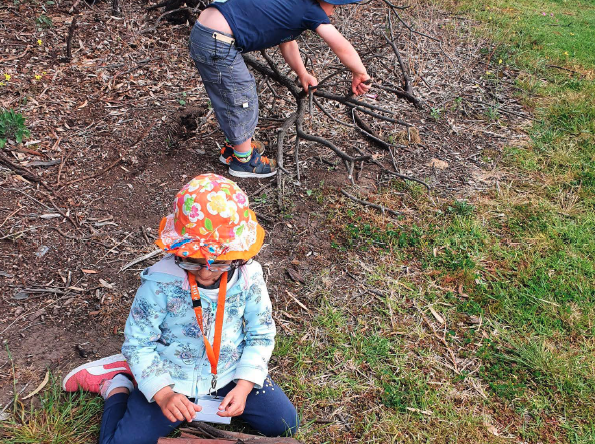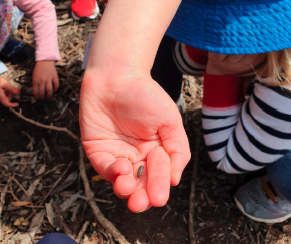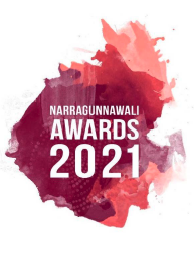Reflections: Learning On Country

Learning On Country – Gowrie Broadmeadows’ Story Of Connecting With Country
By Teagan Ziemer & Ebony Lee, Early Years Leaders, Gowrie Victoria Broadmeadows Valley Early Learning Centre
In 2018, at Gowrie Broadmeadows, we collaborated with our management team to plan for the implementation of a fire pit. After a year of hard work, planning and dedication, we lit our first fire. The learning through this process, on the benefits of coming together, was enormous for our children and educators.
When reflecting on our learning, as a regular part of our programming cycle, we became curious about how we could extend the children’s connection with their natural environment to understanding the history of the land on which they live and play. We then started exploring ideas and possibilities. We felt we were ready for the next stage, which we identified as connecting with Country. This involved planning & advocating for children’s learning to take place outside the Gowrie environment. We saw that connecting to Country was both the extension of risky play introduced during time around the fire pit and an opportunity to build further understanding of the natural environment and the history of these spaces.
We participated in a professional development session on embedding Indigenous perspectives in the curriculum. Key learnings during the session were the importance of connecting to country and allowing children time to gain understanding of what country is as well as providing opportunities to deeply connect with the land on which we play and learn. During a reflective conversation, we thought what better way to achieve this than to start a bush kinder program where we could play and learn directly on the land.
A collaborative discussion with our management team around the possibility of a bush kinder program resulted in lots of positivity, excitement and many reflective, open-ended questions. This ensured, from the beginning, that deep and thorough plans were made. First and foremost, we needed to think about a respectful and culturally safe name for the program whilst ensuring children had ownership over the decision. We brainstormed and reflected with children and decided on the name ‘On Country Kinder’.
Our next step in the process was selecting an appropriate location for ‘On Country Kinder’. We walked to nearby park/bush lands where we could implement the program and chose an open grassy space, away from water, and close to a path. We agreed that the space looked appropriate as a place where children could assess their own risks and engage in open-ended play. Next, we invited the management team to the space , and again many reflective open-ended questions were asked. These included questions around options for children, access to shade and opportunities for challenge. Using these questions as provocations, we reflected on the opportunities for children’s learning and for children to engage in risky play in an open grassy area and with limited natural elements.
As a result, we continued to explore the surrounding park/bushland. This time we crossed a busy road outside the service and discovered a space surrounded by shrubs, trees and water. We explored both sides of the creek and the various walking tracks and observed the potential to cross the creek and eventually extend the classroom to other areas of the parkland as children’s confidence and abilities developed. This raised more questions, ‘How will we get all the resources here and make sure the children are safe?’ ‘How will families drop off children here?’ ‘What if a child doesn’t want to come out for the day?’ ‘How will children access a toilet?’
Throughout these discussions we learnt this project was going to come with a range of barriers and challenges. To ensure we had thought about and covered as much as we could, we interrogated possible scenarios and arrived at solutions within a clear plan.
To ensure the ‘On Country Kinder’ program complied with all relevant aspects of the service’s policies, procedures, and practices, it was essential for us to meet regularly. These meetings included, but were not limited to, writing the risk assessment, mapping out our area, developing permission forms, and collaborating with the management team for advice and answers to questions. We endeavoured to cover unexpected incidents, harm and hazards likely to cause injury and ensured that we were prepared for emergencies or extreme weather events. The risk assessment was a crucial aspect of the setup of ‘On Country Kinder’. This document was created in collaboration with management over a 9 month period through a process of continuous communication and feedback on what we could add, including prompts to think more deeply about risks. At the end of June we received final approval and the document was signed.
As a result of the COVID-19 pandemic our community entered into a stage 3 lock down. Advice around this lockdown resulted in minimal excursions and minimising movement in the community. However, we were still able to take small groups of children to an open space with additional COVID-safety measures, including the mandatory wearing of masks for educators. With these practices it was possible to take the initial steps of embedding ‘On Country Kinder’ into our routine.

Learning On Country – Gowrie Broadmeadows’ Story Of
Connecting With Country
The first excursion to ‘On Country Kinder’ was in the middle of our first lockdown, meaning attendances at the service were low. A small team of educators accompanied 7 children, from both our 3-5 kinder room and our 2-4 kinder room. The experience resulted in positive engagement, lots of excitement and reflection from all children and staff. This excursion gave us great insight into what the program was going to look like and allowed us to align the ‘On Country’ Program with children’s interests. The children showed their creativity, their imagination and their ability to adapt to learning in a space with natural and limited resources. We observed a very empathetic and caring culture whilst the children were on Country.
The excursion started off with an Acknowledgement to Country which included sharing our knowledge about the land we were playing and learning on, Wurundjeri land. This led to setting our initial expectations for the children in respect the space. These were that the children were not to play beyond the natural fence, that the children care for the space and one another, and that any natural resources found on country were to be left on country.
The children began exploring and discussing whether ‘….. big foot lives in this bush land.’ They climbed trees and we discussed the large muscle movements and coordination skills we were observing. The children’s play evolved and an idea then emerged about building a ‘hidey hole’ (tepee made from sticks) to hide from big foot. We discovered lots of rubbish and the children discussed how this makes the bush feel sad and what we could do to help.
From this excursion our program goals were to:
- Care for country – cleaning up the space and leaving natural resources how we found them.
- Connecting to the land and embedding culturally inclusive language.
- Creation of stories using imagination.
- Creation of a tepee with the use of natural resources – discussions around shelter and safety.

We progressively began to increase the number of children coming out on Country.
We progressively began to increase the number of children coming out on Country. Now all three Kindergarten classrooms participate in the excursions in small groups. The goals continue to be embedded across the program, and the commitment to engage children in the development of the program has meant they have taken greater organisational responsibility while out on Country. We now take tongs and rubbish bags to pick up the rubbish and have deep reflective conversations on the importance of leaving natural resources on Country. We have written many stories including ‘What big foot does in the bush’, made ‘crocodile stories from the clouds’, and also created a story of ‘How the ducks got in the river’. The children have been digging for treasure and using this decorate their houses (tepees).

We are all so excited to see what more will come from ‘On Country Kinder’. We continue to work with the children and their families to develop our program, to deepen our connection with Country and to



